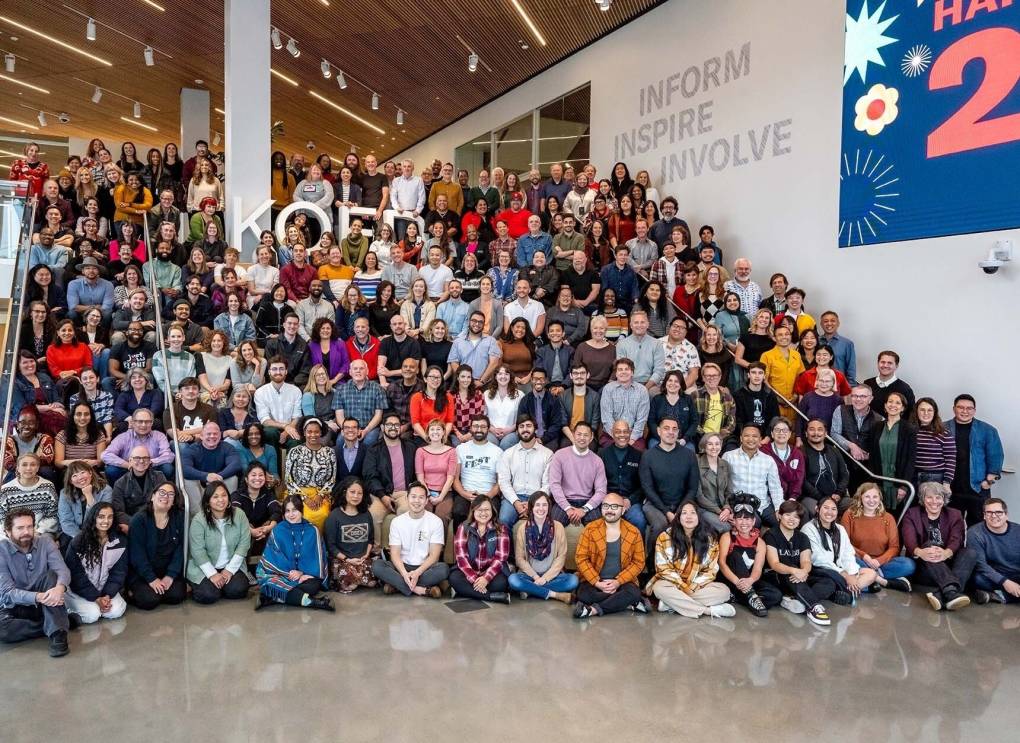KQED Community Representation StatementKQED Community Representation Statement
A Commitment to Inclusion Rooted in Curiosity
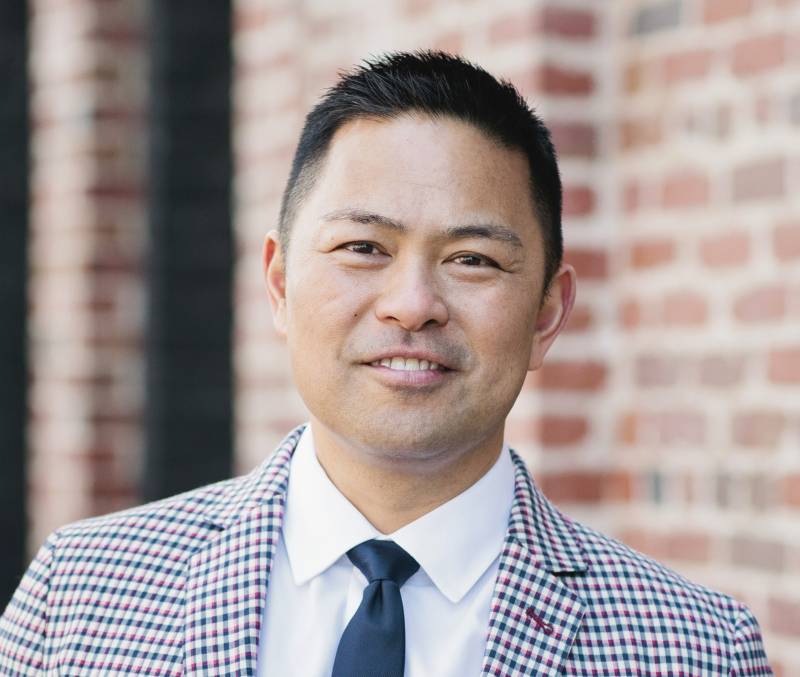
We are proud to present our 2024 Community Representation Statement, which details our progress in advancing an organization that centers on human dignity, equity and belonging. In this report, you will learn more about our efforts to better serve our diverse community in our programming, as well as how we are reaching and engaging new audiences.
We encourage the full participation of individuals of all identities, including those who have historically been excluded based upon race, ethnicity, gender, sexual orientation, age, socioeconomic background, disability and geography. We also think about diversity hand in hand with representation; that is, we think about how well different groups or individuals are included within specific contexts, such as leadership roles or organizational structures. This is about helping all staff be visible, have a voice and participate meaningfully. Our dedication is a fundamental cornerstone of who we are, what we value, and how we serve and operate. We are passionate about empowering our people and our communities to thrive and achieve their full potential.
We know our strength lies in our diversity and that an inclusive culture is essential to the success of our organization. Having a workforce that brings together individuals from different backgrounds, perspectives and experiences helps us attract and retain top talent and create a more dynamic and vital work environment. And implementing equitable policies, practices and processes fosters diversity of thought, creativity and innovation, and it ensures that everyone has access to the same opportunities to grow personally and professionally.
We also believe cultivating curiosity at KQED promotes a healthy and inclusive work environment for all. We encourage our employees to ask questions, actively listen, engage in meaningful conversations, participate in new experiences and understand the world from others’ viewpoints. Curiosity helps to develop empathy and appreciation for the richness that diversity brings.
This mindset of continuous learning and openness to different perspectives also enriches our service. Curiosity inspires our content teams to explore the diverse communities across the Bay Area. Tracking and auditing the sources of our stories safeguards our efforts to present the breadth of human experiences in our region. Curiosity also drives our journalists to challenge the status quo and dig deeper into the subjects they cover, which results in more accurate, comprehensive, insightful and trustworthy information and storytelling.
Finally, we spark curiosity in our community by bringing people together to participate in civic and cultural experiences at our headquarters, helping to break down barriers and build stronger connections so we can collectively face challenges and seek solutions.
We are steadfast in our commitment to cultivating curiosity and full participation of all individuals, because we believe that these principles are essential to our mission and to building a better future for all.
Thank you for your continued support and trust in the work that we do.
— Michael J. Isip, President and CEO
KQED: Representing our Community
KQED seeks to reflect the Bay Area with its outreach and development efforts and by supporting a culture of dignity, equity and belonging. We believe that reflecting our community makes KQED’s content more inclusive, participatory and community powered. While we are committed to broad outreach and fostering an inclusive workplace, all hiring and promotion decisions are based on qualifications, skills, and experience, ensuring that the strongest candidate is selected for each role.
Recruiting and Hiring
KQED engages in outreach to attract a broad group of applicants.
- For all job openings, KQED engages in broad outreach and networking, including attendance at six career fairs at local colleges and universities. Jobs are posted widely.
- Job postings let applicants know that “we value the contributions of marginalized people in society — including Black, Indigenous and all people of color, people with disabilities and LGBTQIA+ people — and we believe that these communities must be represented in the work we do. We strongly encourage members of these communities to apply.”
- We hear from applicants that this Community Representation Statement also helps attract employees who value an inclusive culture.
KQED’s staffing reflects the Bay Area market.
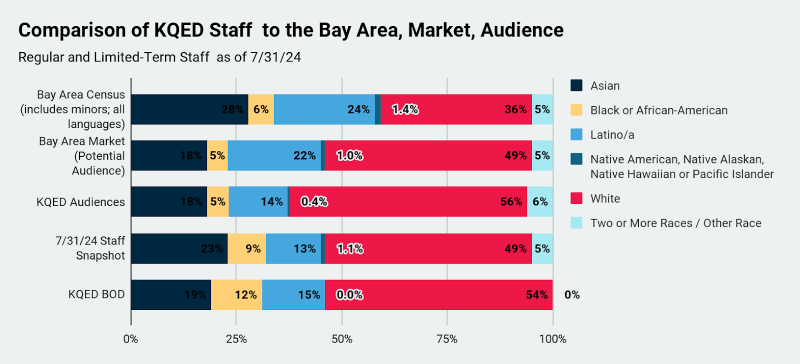
Note: The graph above reflects KQED’s staff race and ethnic representation in the context of the broad demographic categories recognized by the federal government.
Promotions and Leadership Roles
KQED has made efforts over the past several years to increase transparency in the promotion process. This has led to a more equitable distribution of promotions across the organization, which has increased staff retention and leadership representation.
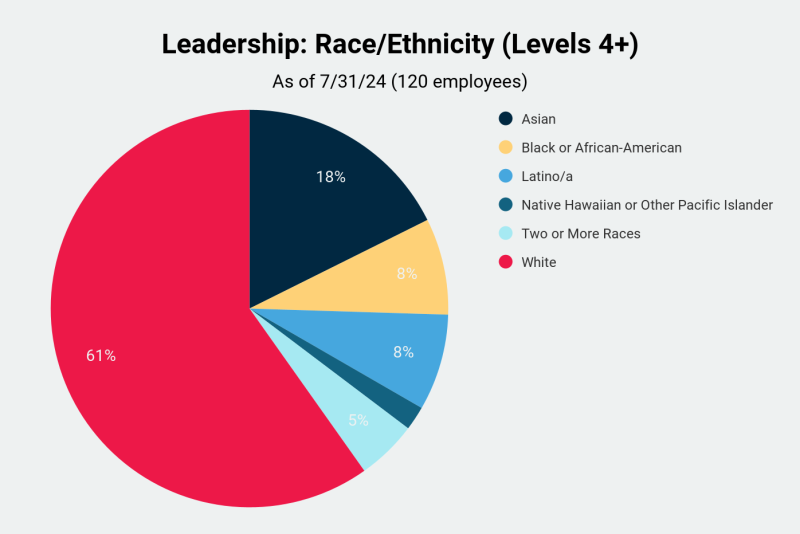
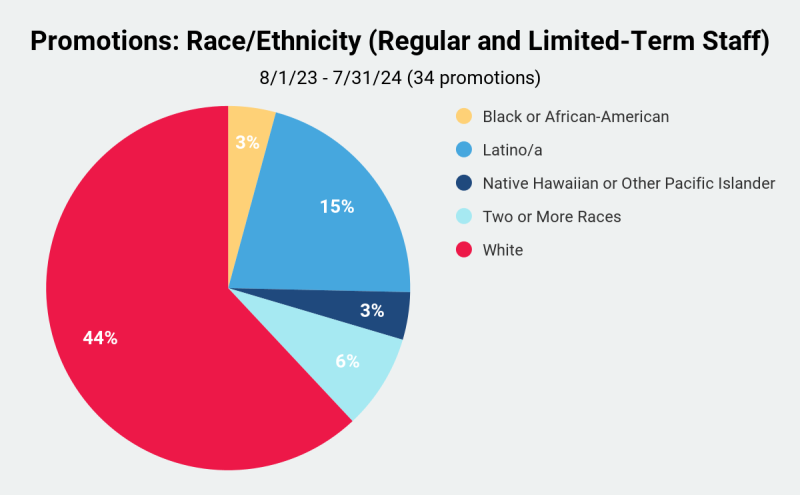
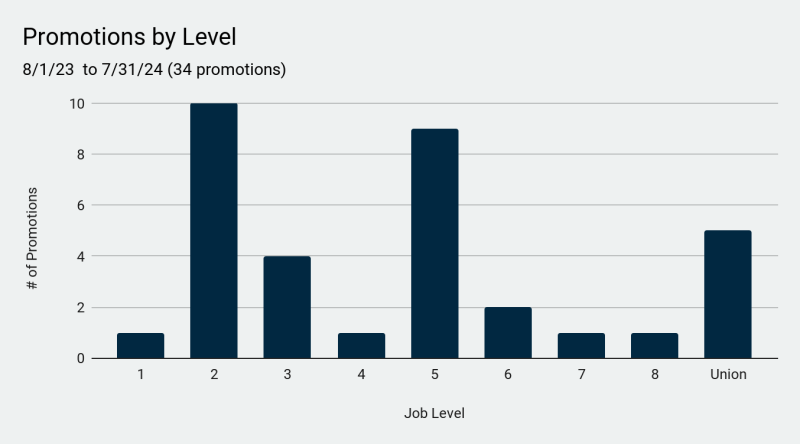
Note: In this context, leadership is considered those in KQED job levels 4-8, which includes managers, directors, senior editors and producers, executive directors, vice presidents and C-Level executives.
62% of our promotions went to employees identifying as female, 35% as male and 3% to those identifying as nonbinary. Several of the promotions went to interns who were offered on-call or regular staff positions following their internships.
Internship Programs
KQED has a robust internship program that is designed so interns gain experience in media while enhancing their skills and/or education inside the classrooms. This past year KQED had 11 types of internships each term throughout various departments, allowing up to a maximum of four interns per type of internship each term. The program is a fully paid internship for periods of six months or longer. KQED hired 49 interns in FY24. Sixty seven percent of the interns identify as female; 27 percent as male; and 4 percent as nonbinary. How interns identify in the context of race/ethnicity is shown in the chart below.
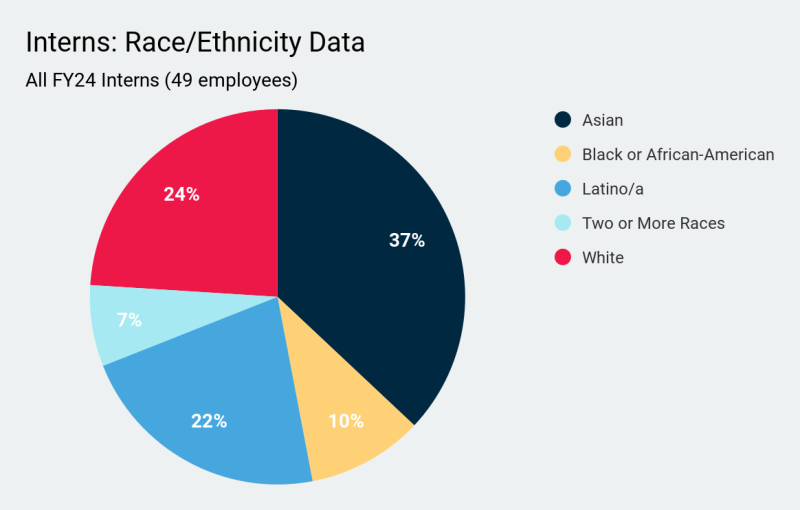
Age Range
KQED also reviews age across the organization and other metrics and utilizes this information in order to ensure its programs and benefits meet the needs of its workforce.
Most of KQED’s regular and limited-term employees are between the ages of 30-59. But Generation Z and Baby Boomers are also represented in our workplace.
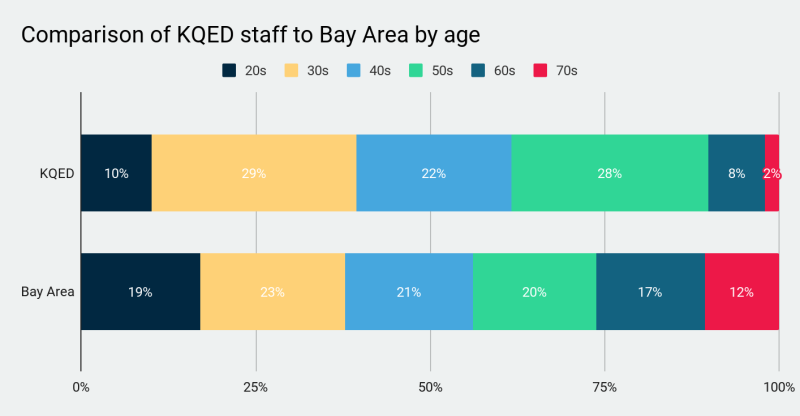
KQED Live Brings Bay Area’s Diverse and Distinctive Communities Together

KQED’s event program, KQED Live, is rooted in the democratic value of assembly — of gathering individuals with distinct cultures and senses of identity on common ground to chart a shared destiny. In this vein, event programming at KQED continues to prioritize creating and promoting spaces wherein diverse Bay Area communities can articulate their lived experiences and express the cultures that ground their visions of collective flourishing. With nearly 60 percent of events created in partnership with nonprofit community and cultural organizations, KQED Live continues to produce a wide-ranging assortment of events that seek to showcase our region’s diverse communities and talents.
In fiscal year 2024, KQED’s live event space brimmed with storytelling showcases that highlighted everyday experiences and heritages. This included a bilingual theatrical documentary that looked at the disproportionate impacts of COVID in San Francisco’s Mission neighborhood and an evening of storytelling dedicated to the personal experiences of those with mixed-race identities. Conversations with cultural influencers like “The Hoodwitch” Bri Luna and artist Hon Yu Mei brought traditional knowledge and practices of Afro-Latino and Chinese cultures to the main stage; both of these cultures have seen resurgent interest in Bay Area communities.
Performances of music, dance and comedy such as the ongoing Latinx cabaret series ¿Dónde Esta Mi Gente?; the Carnaval San Francisco King and Queen Dance Competition; the Living Altars event celebrating cross-cultural expressions of mourning and remembrance in Latinx and Filipinx communities; the interactive Black History Month Dance Party tutorial with historian and dance educator Traci Bartlow; and the Fierce Funny Filipinx night prioritized portrayals of BIPOC creativity and joy. Programs such as the Bay Curious National AIDS Memorial Walking Tour, Disco’s Mighty Real Bay Area Roots and a co-presentation of the new documentary about lesbian activist Sally Gearhart unearthed local queer histories.
Flavorful explorations of culinary heritage, such as pop-up dinner and discussion nights with the Indigenous restaurant Cafe Ohlone and the Black-owned Soul Box Supper Club, showcased Filipinx and Latinx bakers and street bit vendors; a holiday tamale-making workshop brought people together to understand culture through food. And bilingual educational events for children featuring PBS Kids content and book giveaways — in partnership with the San Francisco Public Library and Viva Parks — shared resources and fun for Bay Area families.
Meanwhile, KQED Live is engaging with AAPI audiences thanks to concerted increases in AAPI-focused programs and voices onstage. We launched a new partnership initiative with guest curators and organizations that will offer KQED space to AAPI communities, providing a venue for storytelling and tackling issues most crucial to their lives — from mental health and political activism to cultural preservation.
Overall, the data shows that KQED Live attendees continue to represent a more racially diverse audience than other KQED platforms, with a 46 percent plurality identifying as BIPOC or not exclusively white. The events program will continue pursuing its key goal to “Make KQED Live programming more representative of the Bay Area,” primarily by aiming to increase our Latinx and AAPI audiences. Moving forward, we will pursue this end by increasing Latinx and AAPI sources; partnering with at least six community organizations per producer; producing at least six events in counties outside of San Francisco; and developing at least one kid-friendly program supporting underrepresented families each quarter.
– Ryan Davis, Executive Director, KQED Live
Race/Ethnicity of KQED Live Attendees
August 1, 2023–July 31, 2024
| Race/Ethnicity | Percent |
| Asian | 20.0% |
| Black or African American | 5.7% |
| Latinx | 8.2% |
| Middle Eastern | 0.8% |
| Native American | 0.4% |
| Native Hawaiian/Pacific Islander | 0.6% |
| White | 43.5% |
| Two or More Races | 7.0% |
| Other | 3.1% |
| Prefer Not to Say | 10.6% |
Gender Identity of KQED Live Attendees
| Gender | Percent |
| Male | 23.3% |
| Female | 63.3% |
| Non-Binary/Gender Non-Conforming | 3.0% |
| Prefer Not to Say | 9.8% |
Age Groups of KQED Live Attendees
| Age | Percent |
| 21 and under | 0.7% |
| 22 – 34 | 13.4% |
| 35 – 44 | 16.8% |
| 45 – 54 | 17.5% |
| 55 – 64 | 15.3% |
| 65 and over | 22.1% |
KQED Leans Into Engagement with Latinx Audiences
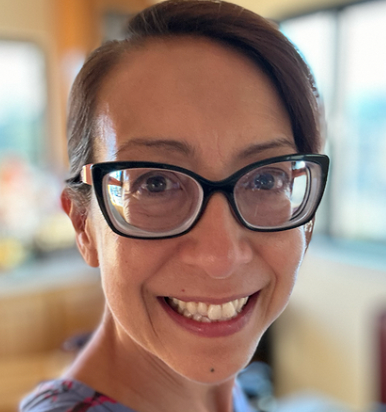
Two years ago KQED embarked on a three-year cross-departmental initiative to better serve Bay Area Latinx communities. At the time, roughly 25 percent of the Bay Area population were Latinx, but just 9 percent of KQED audiences and 6 percent of station members identified as Latinx. A cross-departmental working group was formed with a goal of producing a growth strategy that drew on KQED’s strengths; could produce learnings for other stations; and could potentially serve as a model for engaging with other underserved communities in the future.
In 2023, the initiative supported four existing projects — the multiplatform storytelling project Ofrendas; KQED Live events featuring topics of relevance for Latinx audiences with presenters from the Latinx community; the creation of a Latinx Excellence video series; and growing the station’s KQED en Español Instagram presence.
In 2024, the effort supported four projects including the creation and promotion of a pilot Latinx newsletter called K Onda; an audience-centered strategy for distribution and promotion for KQED’s Spanish-language voter guide; promotion of Latinidad offerings as part of a broader digital ads initiative;, and further growth of KQED Live’s Latinx events offerings. These include Living Altars: Remembrance Across Cultures, Antojitos Mission Street Bites and the Carnaval San Francisco King and Queen Dance Competition.
Looking forward to 2025, we’ll continue our efforts to better serve and reflect the Bay Area Latinx community, including sharing our learnings and successes to this point and beginning to build the diverse audience-service model based on these experiences.
Rodrigo Duran, a KQED Community Advisory Panel member and Executive Director of Carnaval San Francisco, said: “I was drawn to KQED because of their approach to community engagement and relationship building in the Mission District. They were intentional and culturally sensitive to the voices and needs of the Latino community and I was proud to partner with them through Carnaval San Francisco these last three years.”
We’ve been heartened by the support we’ve received throughout this effort and look forward to the considerable work still to be done.
–Vanessa Merina, Vice President, Audience and Development
Source Tracking Reaches a Compliance Milestone
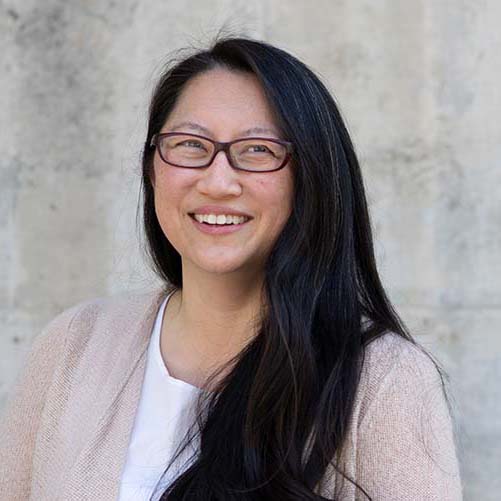
Local news and storytelling are central to what we do at KQED. We aim to center diverse and underrepresented voices to provide a complete look at issues we face in the Bay Area. With this goal in mind, in 2021 KQED began a comprehensive initiative to better capture data about the sources our audiences see and hear in the journalism we make.
When we first began tracking demographic information of our journalists’ sources as part of this project, the first and biggest challenge was getting news staff to operationalize source-tracking procedures consistently. We tracked 5,572 sources in 2022, which grew to 6,712 in 2023. We expect to have close to the same number of source trackers in 2024. This plateau indicates to us that we have reached a milestone in getting us near full compliance in our tracking. With compliance nearly complete, we are now closer to getting the accurate data we had been striving for when we embarked on this project.
KQED’s newsroom has borrowed lessons from other organizations and learned that retroactive source audits (such as thinking about the diversity of your sources) do little to influence behavior in news gathering, so it’s important to front-load the information gathering with conversation. When our journalists engage with sources, they ask sources about their age and how they identify in the context of gender pronouns and race/ethnicity. At KQED, staffers are required to get demographic information from sources during the interview, because talking about race and pronouns often deepens one’s understanding of those around them.
When source tracking is inaccurate — due to lack of compliance — it can typically overrepresent people who want to talk about race or pronouns, and these are usually people of color and those who are better versed in the nuances of gender. That said, our source tracker is not completely accurate in the way we categorize race/ethnicity or rely on pronouns as a proxy for gender. This is because the source tracker also needs to balance the workflow of our journalists who are under deadline, what’s relevant to the story (referencing a pronoun is far more likely to be used than gender) and how much time the source has.
Moving forward, we will continue to collect helpful data by committing to tracking our sources. We are encouraged to see that the source-tracking work is helping staff improve their feelings of cultural understanding as well.
– Ki Sung, Managing Editor, KQED News
Conclusion
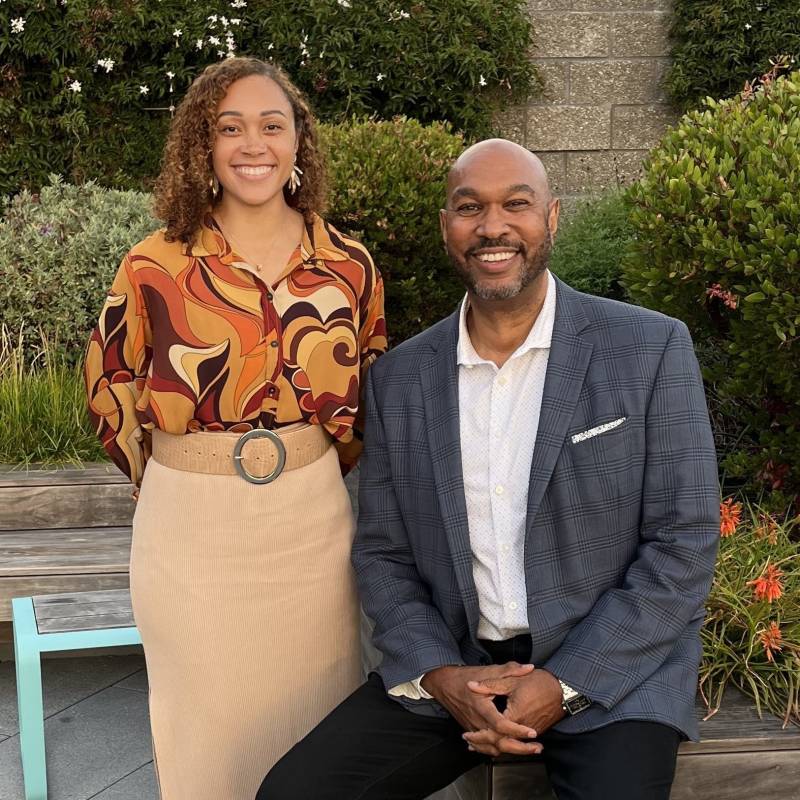
Thank you for reading our 2024 Community Representation Statement. At KQED, our work centers on the curiosity of our staff and most importantly, the communities that we serve and represent. As you’ve seen in this report, our mission to create and provide diverse, inclusive and equitable programming that sparks and satisfies curiosity is the foundation of our work.
As we reflect on the past year, one thing remains clear: Our role is to inform the Bay Area, embolden our audiences to be curious and learn, and bring our community into the conversation. We are committed to serving our communities by ensuring they feel represented, heard and empowered to make fully informed decisions.
Whether it’s broadcasting the morning news or offering opportunities for Bay Area young people to participate in journalism through our Youth Takeover initiative, every action we take is guided by our passion for truth telling, education, and those inquisitive moments that offer perspectives on our local, national and global communities.
Curiosity also drives our commitment to understanding and better serving our diverse audiences. By remaining curious about how we can improve, we’ve been able to launch initiatives that reflect this drive for knowledge and inclusivity. You’ve read about our source-tracking initiative and the exciting programming of KQED Live — very different, but very impactful ways of engaging our community. Additionally, we introduced a pilot newsletter, K Onda, to celebrate and elevate the voices of Latinx changemakers in the Bay Area, further deepening our connection with this vital community.
Our curiosity extends to engaging, educating and connecting with our colleagues to make KQED a great place to work. In the last year, we offered a “Do the Work” anti-oppression workshop series; held several Understanding Bias training sessions for staff; and engaged in a number of department/division-specific small group conversations about various DEI-related topics.
Our programming is as diverse as the communities we serve, spanning television, radio, online, streaming and digital platforms. From local and national news to cultural documentaries, educational programming and high-quality entertainment, we strive to provide content that sparks curiosity and keeps the Bay Area informed and engaged. By amplifying the voices of independent journalists and creators, we ensure a rich tapestry of perspectives that not only represent our community, but also challenge us all to think differently and explore beyond the familiar.
As we look to the future, our mission remains rooted in curiosity: to provide the Bay Area with the tools and content necessary to explore, understand and engage with the increasingly diverse world around us. We invite you to stay curious with us — seek out new stories, embrace diverse viewpoints and find inspiration in the unexpected.
– Eric Abrams, Chief Diversity, Equity and Inclusion Officer and Candace Rucker, Diversity, Equity and Inclusion Program Manager
Notes:
- You may see inconsistent use of terms in some places (for example, Hispanic versus Latinx) in the above report. In most cases, we’ve used language that we feel best represents our audiences, but some language reflects the categories recognized by the federal government or those recognized by a specific tracking platform.
